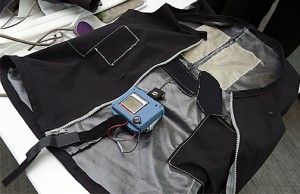Interviews
Hopkins students design life-saving shocks infused shirt
07 Jun '14
5 min read

“Our JHU design team students were able to survey electrophysiologists and their patients who wore the currently approved wearable cardioverter defibrillator,” Cohen said. “The students’ research confirmed my personal findings, namely that the current device has several components that could be improved. The students took this information and with my guidance designed a better mousetrap. The new device incorporates features that should improve patient compliance, ease of use and overall functionality.”
In particular, the student replaced the existing chest harness-style garment with a more comfortable vest-like design made of thin, breathable and stretchable fabric, which also is waterproof for easy cleaning. The shirt can be worn unobtrusively beneath the patient’s clothing. Its electrical components, capable of delivering a 200-joule shock to stop a deadly arrhythmia, are encased in thin pockets on the sides of the garment.
The students also replaced a bulky control box hanging from the patient’s waist with a smaller wireless system worn like a watch on the patient’s wrist. This controller gives the wearer a 30-second warning to stop an impending shock if the system has been activated by a false alarm.
“We did not change any of the science involving how a wearable defibrillator works,” said team member Melinda Chen, who recently finished her senior year at Johns Hopkins. “We just changed the form of the device. We pursued a ‘slip-on and forget’ approach to minimize the user’s need to maintain and interact with the device.”
The students’ prototype has already garnered some attention. It recently won a $10,000 first prize in a competition sponsored by the North American Professionals and Entrepreneurs Council. In that contest, the Johns Hopkins defibrillator group was the only undergraduate team to reach the finals, competing against graduate students and entrants with doctoral and MBA degrees. The team’s mentor, electrophysiologist Cohen, said the students’ wearable defibrillator prototype was also well received recently by physicians, medical researchers and device makers at the non-competitive Stanford Biodesign Conference.
In May, the student inventors showcased their device at the annual Johns Hopkins Biomedical Engineering Design Day event, organized by the university’s Center for Bioengineering Innovation and Design. The wearable defibrillator project won the Most Innovative Design honor and took first place in the People’s Choice Award contest, collecting the most votes from those who attended the event. In addition, Subramanian was selected as the outstanding undergraduate team leader, and team member Caitlin Romanczyk was named outstanding freshman.
Other team members were Taylor Lam, Powei (Billy) Kang, Chun Ming (Ernest) So, Akash Premkumar and Quinn Salditch. The students’ have completed preliminary testing at the Johns Hopkins Hospital Simulation Center, using manikins wired to mimic heart patients. The team has obtained a provisional patent covering some of their innovations. Team members plan to continue to refine the prototype and to confer with medical device makers about advancing the project.
Johns Hopkins
Popular News
Leave your Comments
Editor’s Pick
































-Ltd..jpg?tr=w-120,h-60,c-at_max,cm-pad_resize,bg-ffffff)





.jpg?tr=w-120,h-60,c-at_max,cm-pad_resize,bg-ffffff)
.jpg?tr=w-120,h-60,c-at_max,cm-pad_resize,bg-ffffff)






